泰山碧霞祠景点介绍ppt全英文
- 格式:ppt
- 大小:1.75 MB
- 文档页数:11

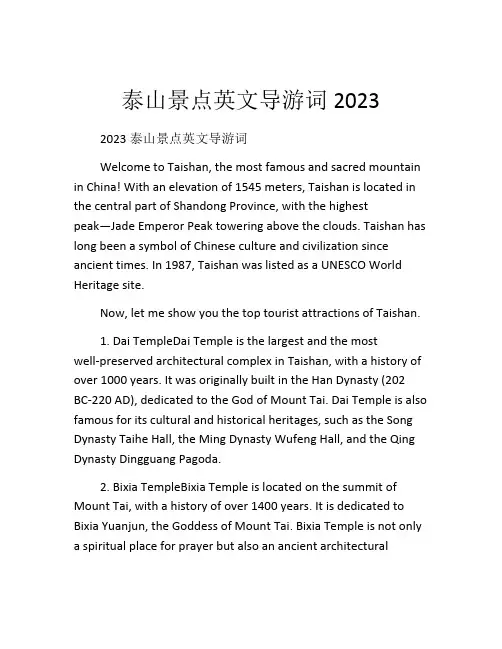
泰山景点英文导游词2023 2023泰山景点英文导游词Welcome to Taishan, the most famous and sacred mountain in China! With an elevation of 1545 meters, Taishan is located in the central part of Shandong Province, with the highest peak—Jade Emperor Peak towering above the clouds. Taishan has long been a symbol of Chinese culture and civilization since ancient times. In 1987, Taishan was listed as a UNESCO World Heritage site.Now, let me show you the top tourist attractions of Taishan.1. Dai TempleDai Temple is the largest and the mostwell-preserved architectural complex in Taishan, with a history of over 1000 years. It was originally built in the Han Dynasty (202 BC-220 AD), dedicated to the God of Mount Tai. Dai Temple is also famous for its cultural and historical heritages, such as the Song Dynasty Taihe Hall, the Ming Dynasty Wufeng Hall, and the Qing Dynasty Dingguang Pagoda.2. Bixia TempleBixia Temple is located on the summit of Mount Tai, with a history of over 1400 years. It is dedicated to Bixia Yuanjun, the Goddess of Mount Tai. Bixia Temple is not only a spiritual place for prayer but also an ancient architecturalwonder for sightseeing. The harmonious layout of the temple reflects the traditional Chinese cultural and aesthetic concepts.3. Jade Emperor PeakJade Emperor Peak is the highest peak of Mount Tai, with an altitude of 1545 meters above sea level. Climbing up to the peak, you can witness the spectacular scenery of sunrise, sea of clouds, and sunset. It is also an amazing place to view the ancient rock inscriptions on the cliff and feel the culture and artifacts of Mount Tai.4. Peach Blossom ValleyPeach Blossom Valley is a natural scenic spot on the southern slope of Mount Tai. In spring, the mountains are covered with peach blossoms, making it a paradise for photography and sightseeing. The valley is also a place of legend and love story in Chinese literature.5. Lingyan TempleLingyan Temple is a famous Buddhist temple in Taishan, with a history of over 1600 years. It is renowned for its unique architecture, exquisite carvings, and vivid statues. For instance, the Jade Buddha Hall, the Thousand Buddhas Hall, and the Arhat Hall. The temple represents the fusion of Buddhist, Taoist and Confucian culture in China.6. HongmenHongmen, also known as the Red Gate, is an ancient military pass on the northern slope of Mount Tai. It is famous for its majestic fortifications, beautiful scenery, and cultural connotations, such as the Three Kingdoms and the Huaiyin Battle. Hongmen is a highlight for hiking and exploring the history of Taishan.7. Taishan Stone Sculpture Art GalleryTaishan Stone Sculpture Art Gallery is a unique cultural attraction in Taishan. It exhibits various stone sculptures, from the Han Dynasty to the present. The art gallery also showcases the rich cultural heritage of Taishan, the ingenuity of artisans, and the beauty of nature.In conclusion, Taishan is a must-visit destination for those who want to experience the profound and diverse culture of China. With its magnificent natural scenery, extraordinary architecture, and rich historical legacy, Taishan is truly a treasure trove of Chinese civilization. Come and explore Taishan, you will be amazed by the beauty and brilliance of this ancient mountain. Thank you for listening!。


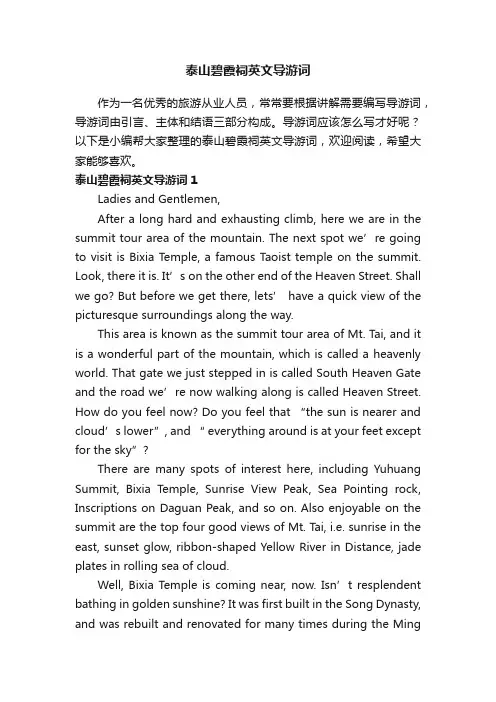
泰山碧霞祠英文导游词作为一名优秀的旅游从业人员,常常要根据讲解需要编写导游词,导游词由引言、主体和结语三部分构成。
导游词应该怎么写才好呢?以下是小编帮大家整理的泰山碧霞祠英文导游词,欢迎阅读,希望大家能够喜欢。
泰山碧霞祠英文导游词1Ladies and Gentlemen,After a long hard and exhausting climb, here we are in the summit tour area of the mountain. The next spot we’re going to visit is Bixia Temple, a famous Taoist temple on the summit. Look, there it is. It’s on the other end of the Heaven Street. Shall we go? But before we get there, lets’ have a quick view of the picturesque surroundings along the way.This area is known as the summit tour area of Mt. Tai, and it is a wonderful part of the mountain, which is called a heavenly world. That gate we just stepped in is called South Heaven Gate and th e road we’re now walking along is called Heaven Street. How do you feel now? Do you feel that “the sun is nearer and cloud’s lower”, and “ everything around is at your feet except for the sky”?There are many spots of interest here, including Yuhuang Summit, Bixia Temple, Sunrise View Peak, Sea Pointing rock, Inscriptions on Daguan Peak, and so on. Also enjoyable on the summit are the top four good views of Mt. Tai, i.e. sunrise in the east, sunset glow, ribbon-shaped Yellow River in Distance, jade plates in rolling sea of cloud.Well, Bixia Temple is coming near, now. Isn’t resplendent bathing in golden sunshine? It was first built in the Song Dynasty, and was rebuilt and renovated for many times during the Mingand Qing dynasties. It was originally named Zhaozhen Temple and got its present name since the Qing Dynasty. It is composed of four gates, three halls, dancing house, drum and bell towers, imperial tablet pavilions, incense burner pavilion. It is divided into two courtyards with a gate between, occupying about 3,900 square meters.According to Daoism, almost everything has a god, for example, the sun, the moon, wind, rain, thunder, wealth and even the door. These gods are enshrined in Taoist monasteries and temples. Their icons are also found in many homes, especially those in the countryside. For example, people worship the God of Wealth in the countryside in hope of achieving big fortunes. The God of Door is supposed to be able to keep away demons. Well, enshrined in this temple is a female statue named Bixia Godness. Then why do people worship her? We know that in the Dai Temple at the foot of the mountain, there is another God named God of Mt Tai. Since the Song Dynasty, Bixia Gldness has gradually taken the place of the God of Mt Tai as the most powerful immortal. She at first was in charge of sons and heirs. Then her power included control of weal and woe, poverty and health. She could cure people of illness and get rid of disasters at the petition of her disciples. So her powerfulness drew numerous men and women from thousand miles away to pray and pilgrimage in her front. So Bixia Godness became the most powerful and major God of Mt Tai. And Bixia Temple now is a precious treasure among the ancient constructions on high mountains with its fine structures and layout.Now ladies and gentlemen, here we are in front of the south gate of Bixia Temple. Let’s step in. You can see there are also another two gates, the east one and the west one. The secondstory built on the south gate is called singing and dancing hall, and the east one is called the bell tower, this is the drum tower. The main structures are in the north courtyard, shall we move on?Ok, here we are. The biggest building in the middle is the Great Hall. It is divided into five rooms. And it’s 24.7 meters long, 15.1 meters wide, and 13.7 meters in height. It has single extending eaves with traditional Chinese wooden structure. That two inscribed board were written respectively by Kangxi and Qianlong, two famous emperors of the Qing Dynasty. Because it is cold and windy on the summit of the mountain, all the tiles were made of iron or bronze. Now, have you paid attention to the bronze tiles on the roof? There are exactly 360 rows of bronze tiles on the roof, which stands for the 360 days of a whole year on Chinese lunar calendar. Enshrined in the middle of the hall is Bixia Godness, who looks kind and dignified. She’s in green blouse, red skirt and golden ornaments. All these colors were popular in old China. Beside the main hall are two other smaller ones, the east one is for Eyesight Godness, and the west one is for the Godness in charge of sons and heirs.Also in this courtyard we could see other smaller buildings. Look at the two double-eave pavilions, in the east is the imperial stone tablet of Qianlong. The inscription means renovating Bixia Temple. In the west is the tablet on which inscribed a poem written by Qianlong.That incense burner opposite the gate was built in the Qing Dynasty. Enshrined in it is also a bronze statue of Bixia Gldness. And beside are two bronze tablets built in the Qing Dynasty. The left one was built in 1615, on it records how the pavilion was built. The right one was built in 1625, and on it records the history of Bixia Temple.Ok, everybody. So much for Bixia Temple. We have seen the statue of Bixia Godness, the three main halls, the imperial pavilion and tablets, the bell and drum towers. Shall we move on to the next spot?Ladies and Gentlemen,After a long hard and exhausting climb, here we are in the summit tour area of the mountain. The next spot we’re going to visit is Bixia Temple, a famous Taoist temple on the summit. Look, there it is. It’s on the other end of the Heaven Street. Shall we go? But before we get there, lets’ have a quick view of the picturesque surroundings along the way.This area is known as the summit tour area of Mt. Tai, and it is a wonderful part of the mountain, which is called a heavenly world. That gate we just stepped in is called South Heaven Gate and the road we’re now walking along is called Heaven Street. How do you feel now? Do you feel that “the sun is nearer and cloud’s lower”, and “ everything around is at your feet except for the sky”?There are many spots of interest here, including Yuhuang Summit, Bixia Temple, Sunrise View Peak, Sea Pointing rock, Inscriptions on Daguan Peak, and so on. Also enjoyable on the summit are the top four good views of Mt. Tai, i.e. sunrise in the east, sunset glow, ribbon-shaped Yellow River in Distance, jade plates in rolling sea of cloud.Well, Bixia Temple is coming near, now. Isn’t resplendent bathing in golden sunshine? It was first built in the Song Dynasty, and was rebuilt and renovated for many times during the Ming and Qing dynasties. It was originally named Zhaozhen Temple and got its present name since the Qing Dynasty. It is composed of four gates, three halls, dancing house, drum and bell towers, imperial tablet pavilions, incense burner pavilion. It is divided intotwo courtyards with a gate between, occupying about 3,900 square meters.According to Daoism, almost everything has a god, for example, the sun, the moon, wind, rain, thunder, wealth and even the door. These gods are enshrined in Taoist monasteries and temples. Their icons are also found in many homes, especially those in the countryside. For example, people worship the God of Wealth in the countryside in hope of achieving big fortunes. The God of Door is supposed to be able to keep away demons. Well, enshrined in this temple is a female statue named Bixia Godness. Then why do people worship her? We know that in the Dai Temple at the foot of the mountain, there is another God named God of Mt Tai. Since the Song Dynasty, Bixia Gldness has gradually taken the place of the God of Mt Tai as the most powerful immortal. She at first was in charge of sons and heirs. Then her power included control of weal and woe, poverty and health. She could cure people of illness and get rid of disasters at the petition of her disciples. So her powerfulness drew numerous men and women from thousand miles away to pray and pilgrimage in her front. So Bixia Godness became the most powerful and major God of Mt Tai. And Bixia Temple now is a precious treasure among the ancient constructions on high mountains with its fine structures and layout.Now ladies and gentlemen, here we are in front of the south gate of Bixia Temple. Let’s step in. You can see there are also another two gates, the east one and the west one. The second story built on the south gate is called singing and dancing hall, and the east one is called the bell tower, this is the drum tower. The main structures are in the north courtyard, shall we move on?Ok, here we are. The biggest building in the middle is theGreat Hall. It is divided into five rooms. And it’s 24.7 meters long, 15.1 meters wide, and 13.7 meters in height. It has single extending eaves with traditional Chinese wooden structure. That two inscribed board were written respectively by Kangxi and Qianlong, two famous emperors of the Qing Dynasty. Because it is cold and windy on the summit of the mountain, all the tiles were made of iron or bronze. Now, have you paid attention to the bronze tiles on the roof? There are exactly 360 rows of bronze tiles on the roof, which stands for the 360 days of a whole year on Chinese lunar calendar. Enshrined in the middle of the hall is Bixia Godness, who looks kind and dignified. She’s in green blouse, red skirt and golden ornaments. All these colors were popular in old China. Beside the main hall are two other smaller ones, the east one is for Eyesight Godness, and the west one is for the Godness in charge of sons and heirs.Also in this courtyard we could see other smaller buildings. Look at the two double-eave pavilions, in the east is the imperial stone tablet of Qianlong. The inscription means renovating Bixia Temple. In the west is the tablet on which inscribed a poem written by Qianlong.That incense burner opposite the gate was built in the Qing Dynasty. Enshrined in it is also a bronze statue of Bixia Gldness. And beside are two bronze tablets built in the Qing Dynasty. The left one was built in 1615, on it records how the pavilion was built. The right one was built in 1625, and on it records the history of Bixia Temple.Ok, everybody. So much for Bixia Temple. We have seen the statue of Bixia Godness, the three main halls, the imperial pavilion and tablets, the bell and drum towers. Shall we move on to the next spot?泰山碧霞祠英文导游词2The city of Taian, is 150 meters above sea level. Most of the principal scenic spots and historical remains are clustered along an axis extending from the city to the top of the mountain. They are the result of a long historical Process, and are ingeniously placed in order to take advantage of the surrounding topography.Chinese mythology has it that Mt.Tai was formed from the head of PanGu, one of chinese creators.His four limbs Formed another four mountains. These five mountains are located in the East, West,South,North and the center of China. Mount Tai in the East is the one that is generally the most admired.The Azure Cloud T emple is the best preserved old structure on Mt.Taishan, which still retains the style and appearance of the Ming an Qing dynasties. Its importance rests with its Good combination of architecture, painting, carving and forest, an illustration of ancient Cinenese culture. It has a building area of 3900 square meters. According to records,it wasFirst built in 1009 of the Song Dynasty, and rebuilt in the Ming and Qing dynasties. Now it is a large ancient complex on the top of Mt. taishan.The Azure Cloud T emple consists of 12 large structures, such as the Main Hall, the Annexed Hall,the joss stick Hall, the Main Gate, the imperial Stele Pavillion, the Bell Tower and The Sacred Gate. The temple is divided by the main gate into two courtyards. The front counrtyard has three gates. On the Soouth Sacred Gate stand three dancing and singing roomsOver a fire floor where pilgrims burn Joss sticks. Facing the gate is a screen wall, inscribed four Chinese characters万代瞻仰meaning admiration by generations. Two annexed rooms extend notyhward to connect the East Sacred Gate and the West sacred Gate.The main gate is the bound between the front courtyard andthe rear courtyard. Inside the gate is the principal part of the Azyre Cloud Temple. In the center of the courtyard is the Joss stick pavilion, where enshrined is a bronze figurine of the aupreme Lord. On either side of the pavilion stands a huge stele. Besides the Azure Cloud Tem;le itself, the Buddha’s Halo is another miraculous phenomenon. Of the 128 historical sites under preservation on Mt. Taishan, the Azure Cloud Temple is the most important one.A common saying goes that a mountain will be intelligent if there lives an immortal, no matter how high it is. Mt. Taishan is not only high but also intelligent. Rising abruptly and imposingly1545 meters above sea level from a vast plain, Mt. Taishan became the holy land where emperors of different dynasties made their personal pilgrimages and held ssacrificiall ceremonies. StandjingOn the top of Mt. Taishan, the Azure Cloud Temple, the chief place where sacrificial ceremonies were made, is the highlight attraction on Mt.Taishan.If you are tired you can have a rest here or take photos. mind you, in 5 minutes. who know the origin of BaoTu Spring, please think it over and I will tell you the reason after 5 minutes.Thank you.。
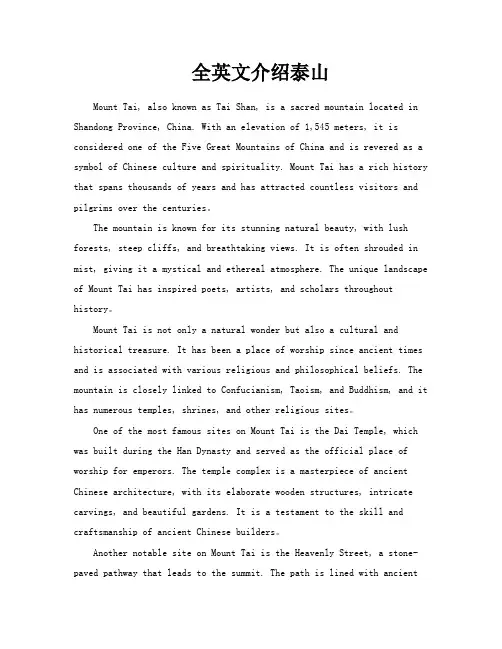
全英文介绍泰山Mount Tai, also known as Tai Shan, is a sacred mountain located in Shandong Province, China. With an elevation of 1,545 meters, it is considered one of the Five Great Mountains of China and is revered as a symbol of Chinese culture and spirituality. Mount Tai has a rich history that spans thousands of years and has attracted countless visitors and pilgrims over the centuries。
The mountain is known for its stunning natural beauty, with lush forests, steep cliffs, and breathtaking views. It is often shrouded in mist, giving it a mystical and ethereal atmosphere. The unique landscape of Mount Tai has inspired poets, artists, and scholars throughout history。
Mount Tai is not only a natural wonder but also a cultural and historical treasure. It has been a place of worship since ancient times and is associated with various religious and philosophical beliefs. The mountain is closely linked to Confucianism, Taoism, and Buddhism, and it has numerous temples, shrines, and other religious sites。
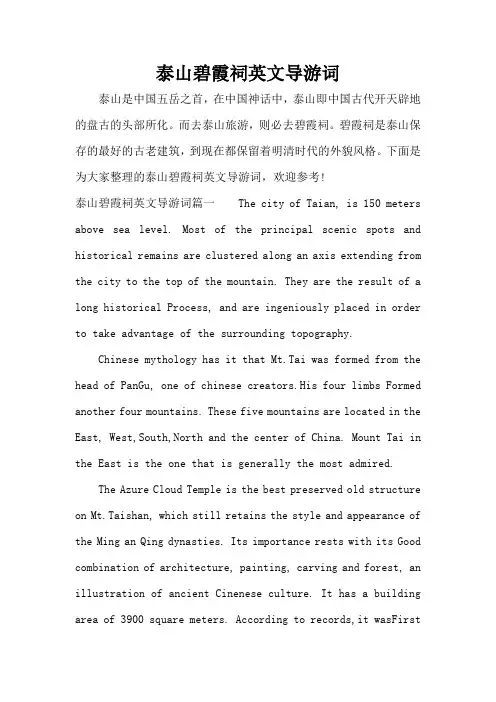
泰山碧霞祠英文导游词泰山是中国五岳之首,在中国神话中,泰山即中国古代开天辟地的盘古的头部所化。
而去泰山旅游,则必去碧霞祠。
碧霞祠是泰山保存的最好的古老建筑,到现在都保留着明清时代的外貌风格。
下面是为大家整理的泰山碧霞祠英文导游词,欢迎参考!泰山碧霞祠英文导游词篇一The city of Taian, is 150 meters above sea level. Most of the principal scenic spots and historical remains are clustered along an axis extending from the city to the top of the mountain. They are the result of a long historical Process, and are ingeniously placed in order to take advantage of the surrounding topography.Chinese mythology has it that Mt.Tai was formed from the head of PanGu, one of chinese creators.His four limbs Formed another four mountains. These five mountains are located in the East, West,South,North and the center of China. Mount Tai in the East is the one that is generally the most admired.The Azure Cloud Temple is the best preserved old structure on Mt.Taishan, which still retains the style and appearance of the Ming an Qing dynasties. Its importance rests with its Good combination of architecture, painting, carving and forest, an illustration of ancient Cinenese culture. It has a building area of 3900 square meters. According to records,it wasFirstbuilt in 1009 of the Song Dynasty, and rebuilt in the Ming and Qing dynasties. Now it is a large ancient complex on the top of Mt. taishan.The Azure Cloud Temple consists of 12 large structures, such as the Main Hall, the Annexed Hall,the joss stick Hall, the Main Gate, the imperial Stele Pavillion, the Bell Tower and The Sacred Gate. The temple is divided by the main gate into two courtyards. The front counrtyard has three gates. On the Soouth Sacred Gate stand three dancing and singing roomsOver a fire floor where pilgrims burn Joss sticks. Facing the gate is a screen wall, inscribed four Chinese characters 万代瞻仰meaning admiration by generations. Two annexed rooms extend notyhward to connect the East Sacred Gate and the West sacred Gate.The main gate is the bound between the front courtyard and the rear courtyard. Inside the gate is the principal part of the Azyre Cloud Temple. In the center of the courtyard is the Joss stick pavilion, where enshrined is a bronze figurine of the aupreme Lord. On either side of the pavilion stands a huge stele. Besides the Azure Cloud Tem;le itself, the Buddha’s Halo is another miraculous phenomenon. Of the 128 historical sites under preservation on Mt. Taishan, theAzure Cloud Temple is the most important one.A common saying goes that a mountain will be intelligent if there lives an immortal, no matter how high it is. Mt. Taishan is not only high but also intelligent. Rising abruptly and imposingly1545 meters above sea level from a vast plain, Mt. Taishan became the holy land where emperors of different dynasties made their personal pilgrimages and held ssacrificiall ceremonies. StandjingOn the top of Mt. Taishan, the Azure Cloud Temple, the chief place where sacrificial ceremonies were made, is the highlight attraction on Mt.Taishan.If you are tired you can have a rest here or take photos. mind you, in 5 minutes. who know the origin of BaoTu Spring, please think it over and I will tell you the reason after 5 minutes.Thank you.泰山碧霞祠英文导游词篇二Ladies and Gentlemen, After a long hard and exhausting climb, here we are in the summit tour area of the mountain. The next spot we’re going to visit is Bixia Temple, a famous Taoist temple on the summit. Look, there it is. It’s on the other end of the Heaven Street. Shall we go? But before we get there, lets’have a quick view of the picturesque surroundings along the way.This area is known as the summit tour area of Mt. Tai, and it is a wonderful part of the mountain, which is called a heavenly world. That gate we just stepped in is called South Heaven Gate and the road we’re now walking along is called Heaven Street. How do you feel now? Do you feel that the sun is nearer and cloud’s lower, and everything around is at your feet except for the sky?There are many spots of interest here, including Yuhuang Summit, Bixia Temple, Sunrise View Peak, Sea Pointing rock, Inscriptions on Daguan Peak, and so on. Also enjoyable on the summit are the top four good views of Mt. Tai, i.e. sunrise in the east, sunset glow, ribbon-shaped Yellow River in Distance, jade plates in rolling sea of cloud.Well, Bixia Temple is coming near, now. Isn’t resplendent bathing in golden sunshine? It was first built in the Song Dynasty, and was rebuilt and renovated for many times during the Ming and Qing dynasties. It was originally named Zhaozhen Temple and got its present name since the Qing Dynasty. It is composed of four gates, three halls, dancing house, drum and bell towers, imperial tablet pavilions, incense burner pavilion. It is divided into two courtyards with a gate between,occupying about 3,900 square meters.According to Daoism, almost everything has a god, for example, the sun, the moon, wind, rain, thunder, wealth and even the door. These gods are enshrined in Taoist monasteries and temples. Their icons are also found in many homes, especially those in the countryside. For example, people worship the God of Wealth in the countryside in hope of achieving big fortunes. The God of Door is supposed to be able to keep away demons. Well, enshrined in this temple is a female statue named Bixia Godness. Then why do people worship her? We know that in the Dai Temple at the foot of the mountain, there is another God named God of Mt Tai. Since the Song Dynasty, Bixia Gldness has gradually taken the place of the God of Mt Tai as the most powerful immortal. She at first was in charge of sons and heirs. Then her power included control of weal and woe, poverty and health. She could cure people of illness and get rid of disasters at the petition of her disciples. So her powerfulness drew numerous men and women from thousand miles away to pray and pilgrimage in her front. So Bixia Godness became the most powerful and major God of Mt Tai. And Bixia Temple now is a precious treasure among the ancient constructions on high mountains with its fine structures and layout.Now ladies and gentlemen, here we are in front of the south gate of Bixia Temple. Let’s step in. You can see there are also another two gates, the east one and the west one. The second story built on the south gate is called singing and dancing hall, and the east one is called the bell tower, this is the drum tower. The main structures are in the north courtyard, shall we move on?Ok, here we are. The biggest building in the middle is the Great Hall. It is divided into five rooms. And it’s 24.7 meters long, 15.1 meters wide, and 13.7 meters in height. It has single extending eaves with traditional Chinese wooden structure. That two inscribed board were written respectively by Kangxi and Qianlong, two famous emperors of the Qing Dynasty. Because it is cold and windy on the summit of the mountain, all the tiles were made of iron or bronze. Now, have you paid attention to the bronze tiles on the roof? There are exactly 360 rows of bronze tiles on the roof, which stands for the 360 days of a whole year on Chinese lunar calendar. Enshrined in the middle of the hall is Bixia Godness, who looks kind and dignified. She’s in green blouse, red skirt and golden ornaments. All these colors were popular in old China. Beside the main hall are two other smaller ones, the east one is forEyesight Godness, and the west one is for the Godness in charge of sons and heirs.Also in this courtyard we could see other smaller buildings. Look at the two double-eave pavilions, in the east is the imperial stone tablet of Qianlong. The inscription means renovating Bixia Temple. In the west is the tablet on which inscribed a poem written by Qianlong.That incense burner opposite the gate was built in the Qing Dynasty. Enshrined in it is also a bronze statue of Bixia Gldness. And beside are two bronze tablets built in the Qing Dynasty. The left one was built in 1615, on it records how the pavilion was built. The right one was built in 1625, and on it records the history of Bixia Temple.Ok, everybody. So much for Bixia Temple. We have seen the statue of Bixia Godness, the three main halls, the imperial pavilion and tablets, the bell and drum towers. Shall we move on to the next spot?Ladies and Gentlemen,After a long hard and exhausting climb, here we are in the summit tour area of the mountain. The next spot we’re going to visit is Bixia Temple, a famous Taoist temple on the summit. Look, there it is. It’s on the other end of the Heaven Street. Shall we go? But before we get there, lets’have a quick view of the picturesque surroundings along the way.This area is known as the summit tour area of Mt. Tai, and it is a wonderful part of the mountain, which is called a heavenly world. That gate we just stepped in is called South Heaven Gate and the road we’re now walking along is called Heaven Street. How do you feel now? Do you feel that the sun is nearer and cloud’s lower, and everything around is at your feet except for the sky?There are many spots of interest here, including Yuhuang Summit, Bixia Temple, Sunrise View Peak, Sea Pointing rock, Inscriptions on Daguan Peak, and so on. Also enjoyable on the summit are the top four good views of Mt. Tai, i.e. sunrise in the east, sunset glow, ribbon-shaped Yellow River in Distance, jade plates in rolling sea of cloud.Well, Bixia Temple is coming near, now. Isn’t resplendent bathing in golden sunshine? It was first built in the Song Dynasty, and was rebuilt and renovated for many times during the Ming and Qing dynasties. It was originally named Zhaozhen Temple and got its present name since the Qing Dynasty. It is composed of four gates, three halls, dancing house, drum and bell towers, imperial tablet pavilions, incense burner pavilion. It is divided into two courtyards with a gate between,occupying about 3,900 square meters.According to Daoism, almost everything has a god, for example, the sun, the moon, wind, rain, thunder, wealth and even the door. These gods are enshrined in Taoist monasteries and temples. Their icons are also found in many homes, especially those in the countryside. For example, people worship the God of Wealth in the countryside in hope of achieving big fortunes. The God of Door is supposed to be able to keep away demons. Well, enshrined in this temple is a female statue named Bixia Godness. Then why do people worship her? We know that in the Dai Temple at the foot of the mountain, there is another God named God of Mt Tai. Since the Song Dynasty, Bixia Gldness has gradually taken the place of the God of Mt Tai as the most powerful immortal. She at first was in charge of sons and heirs. Then her power included control of weal and woe, poverty and health. She could cure people of illness and get rid of disasters at the petition of her disciples. So her powerfulness drew numerous men and women from thousand miles away to pray and pilgrimage in her front. So Bixia Godness became the most powerful and major God of Mt Tai. And Bixia Temple now is a precious treasure among the ancient constructions on high mountains with its fine structures and layout.Now ladies and gentlemen, here we are in front of the south gate of Bixia Temple. Let’s step in. You can see there are also another two gates, the east one and the west one. The second story built on the south gate is called singing and dancing hall, and the east one is called the bell tower, this is the drum tower. The main structures are in the north courtyard, shall we move on?Ok, here we are. The biggest building in the middle is the Great Hall. It is divided into five rooms. And it’s 24.7 meters long, 15.1 meters wide, and 13.7 meters in height. It has single extending eaves with traditional Chinese wooden structure. That two inscribed board were written respectively by Kangxi and Qianlong, two famous emperors of the Qing Dynasty. Because it is cold and windy on the summit of the mountain, all the tiles were made of iron or bronze. Now, have you paid attention to the bronze tiles on the roof? There are exactly 360 rows of bronze tiles on the roof, which stands for the 360 days of a whole year on Chinese lunar calendar. Enshrined in the middle of the hall is Bixia Godness, who looks kind and dignified. She’s in green blouse, red skirt and golden ornaments. All these colors were popular in old China. Beside the main hall are two other smaller ones, the east one is forEyesight Godness, and the west one is for the Godness in charge of sons and heirs.Also in this courtyard we could see other smaller buildings. Look at the two double-eave pavilions, in the east is the imperial stone tablet of Qianlong. The inscription means renovating Bixia Temple. In the west is the tablet on which inscribed a poem written by Qianlong.That incense burner opposite the gate was built in the Qing Dynasty. Enshrined in it is also a bronze statue of Bixia Gldness. And beside are two bronze tablets built in the Qing Dynasty. The left one was built in 1615, on it records how the pavilion was built. The right one was built in 1625, and on it records the history of Bixia Temple.Ok, everybody. So much for Bixia Temple. We have seen the statue of Bixia Godness, the three main halls, the imperial pavilion and tablets, the bell and drum towers. Shall we move on to the next spot?word格式/A4打印/下载后可修改11。
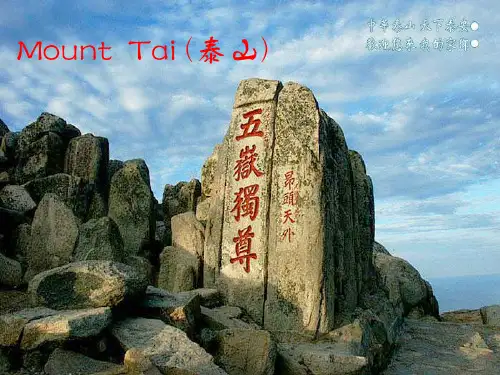
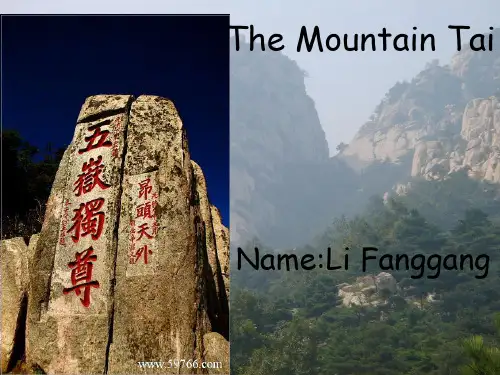


泰山景点英文介绍Hello everyone! Today, I'm going to tell you about the amazing Mount Tai.I remember the first time I went to Mount Tai, it was an unforgettable experience. I went there with my parents and a group of friends. We were all so excited and couldn't wait to explore this magnificent place.When we arrived at the foot of the mountain, we saw a bunch of tourists who were also eager to start their journey. There was a little boy, probably around eight years old, jumping up and down and shouting, "I'm going to climb to the top!" His enthusiasm really infected all of us.As we began to climb, the scenery was just breathtaking. The lush trees, the ancient stones, and the clear streams along the way made us feel like we were in a fairyland. My friend, Lisa, kept saying, "Oh my god, this is so beautiful!" and taking pictures non-stop.After climbing for a while, we stopped to take a rest. There was an old couple sitting beside us. They were sharing their stories of climbing Mount Tai when they were young. They said that climbing Mount Tai was not only a physical challenge but also a spiritual journey.Finally, after hours of effort, we reached the top. The view was simply stunning. We could see the clouds beneath our feet and the vast land stretching out in the distance. We all shouted with joy and excitement.Mount Tai is not just a mountain; it's a place full of stories, memories, and adventures. If you haven't been there yet, you should definitely give it a try. I'm sure you'll have an unforgettable time just like I did.So, that's my story about Mount Tai. Hope you'll love it too!。
五岳景点介绍英文版The Five Great Mountains, also known as the Five Sacred Mountains, are a group of five prominent mountains in China. These mountains have been revered in Chinese traditional culture for centuries and are considered sacred in Taoism, Buddhism, and Confucianism. Each of the Five Great Mountains has its own unique features and historical significance, making them popular pilgrimage sites andtourist destinations.1. Mount Tai (泰山)。
Mount Tai, located in Shandong province, is the easternmost and most famous of the Five Great Mountains. It is known for its majestic peaks, ancient temples, and the famous "Heavenly Street" stone staircase. Mount Tai hasbeen a place of worship and pilgrimage for thousands of years and is a UNESCO World Heritage Site.2. Mount Hua (华山)。
Mount Hua, situated in Shaanxi province, is knownfor its steep and narrow paths, breathtaking cliffs, and stunning natural scenery. It is often considered the most dangerous of the Five Great Mountains, attracting thrill-seekers and adventurers. The mountain is also home to several Taoist temples and has a rich cultural andhistorical significance.3. Mount Heng (衡山)。
泰山英文介绍About Mount Tai (泰山英文介绍)Mount Tai in Shandong was included in "World Cultural and Natural Heritage" by UNESCO in Dec 1987.Mount Tai, a typical representative of the Chinese famous traditional mountains, is a mountain with a long history and a special historic status. In 1982, Mount Tai was up into the list of State key scenic spots(国家重点旅游景点)and was formally listed in the directory(名录)of World Natural and Cultural Heritage in 1987. It becomes a precious heritage of human being. Mount Tai is located in the east of North China Plain and the middle of Shandong province erecting(矗立)from the Shandong hills(丘陵). It is prominent around other hills. The prominent peak, Yuhuang Peak, is 1545 meters high and is located at degree east longitude(东经), degree north latitude(北纬). The south of Mount Tai is higher than the north. Its southern foot of mountain begins from Tai'an city and its northern foot of mountain stops in Jinan City, the distance between which is 60kms. The transportation there is convenient with the Jinghu railway passing by in the west. In its north is Jinan city, which has another name of "Spring City". The distance between Mount Tai and Qufu is 70kms. Many roads and railways such as Taifei, Taixin, Taining, and Taiji meet in Tai'an city, which is just located in the south of Mount Tai.Mount Tai is in a superior geographic location with abundant water and thermal resources, and it belongs to monsoon climate of medium latitudes(温带季风气候). As regard to its historic position, in the ancient times, Mount Tai is a developed region—— in the lower reaches(下游) of the Yellow River. As regard to itscultural position, it is the center of Dongyi Culture. At the southern foot of Mount Tai, there is Dawenkou Culture, and there is Longshan Culture at its northern foot, it is the center of Qi and Lu. And its transportation is more superior. Mount Tai is in a key position where the railway from central plains to Shandong peninsula meets the railway connecting the south and north of the east coast. There are no hills between Mount Tai and the capitals in the ancient times as well as the developed regions. This superior condition helps Mount Tai gain the first position among the Five Sacred Mountains in China.As a mountainous scenic spot, Mount Tai has high values in terms of aesthetics(美学) and science, especially the aesthetic value, which is the foundation for Mount Tai to become a famous mountain in the history and the World Natural and Cultural Heritage today. For thousands of years, during the process of studying on Mount Tai in terms of adoration[,?d?'rei??n]崇拜, taste(审美), religion and science, the people have created extremely abundant and valued Taishan scenic culture. Moreover, in the Taishan scenic culture, the natural scene plays the key role with the literacy scene assisting. The nature and culture penetrate into each other. Here we can see the ideas of philosophy, aesthetics and science about the harmonious development of Heaven, Earth and Mankind(天地人). Thereby, either from the point of time or space, Mount Tai contains extremely abundant contents with high aesthetic, scientific and historic value. We can say that Mount Tai is the symbol of Chinese spiritual culture and the unique heritage of the world.孔庙The Temple of Confucius孔府The Confucian Family Mansion孔林The Cemetery of Confucius。